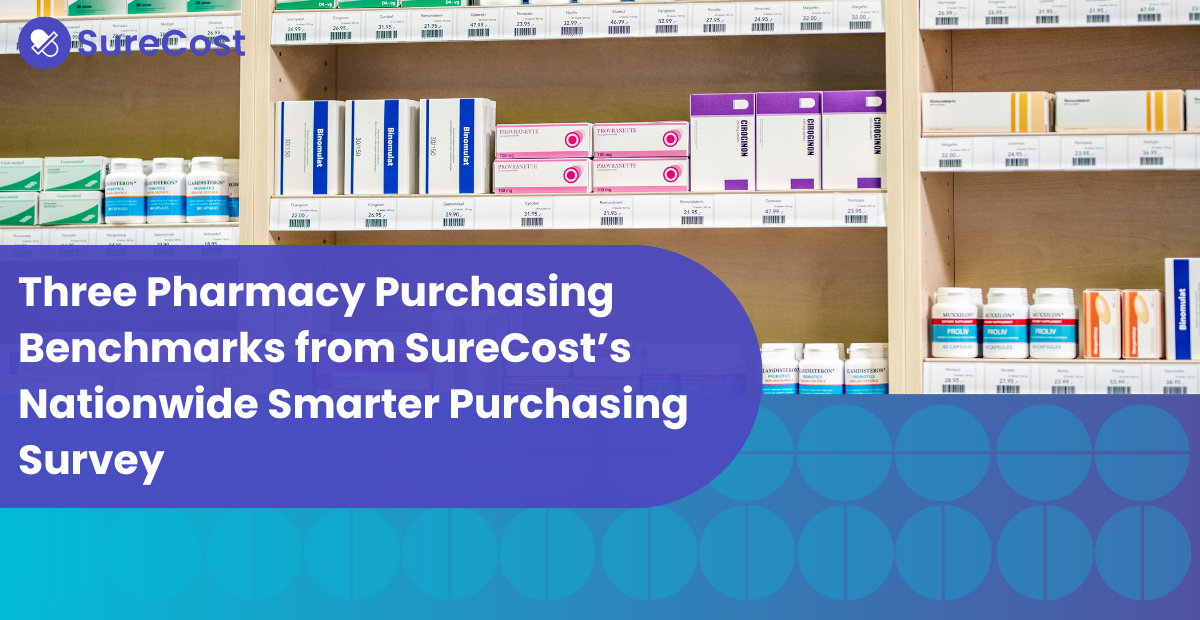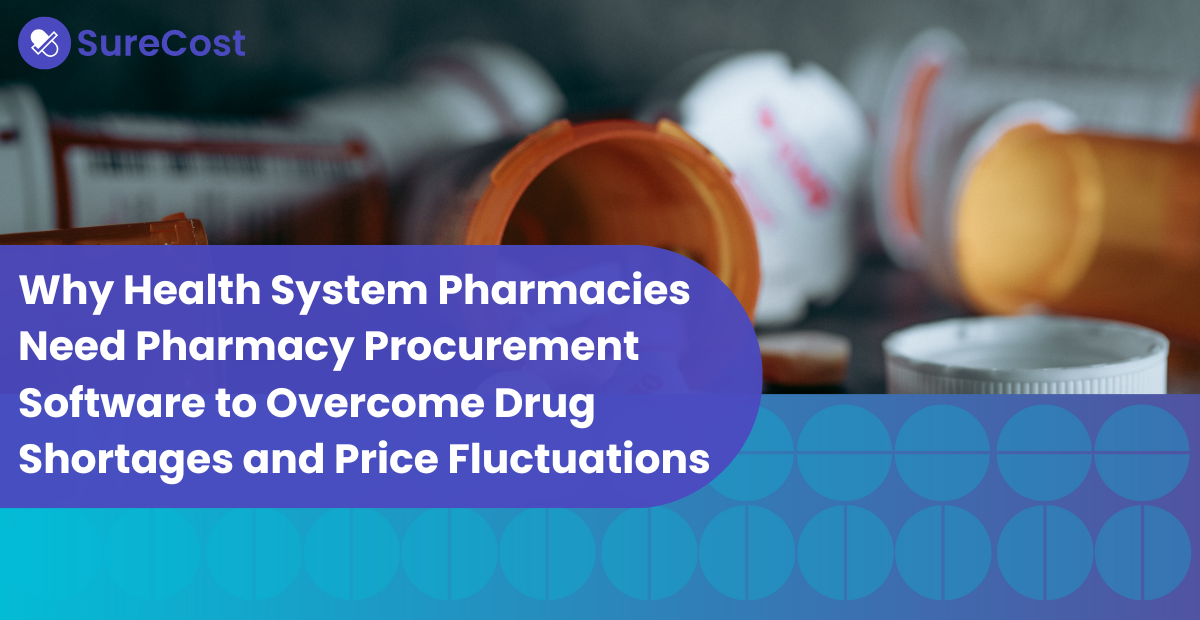For pharmacies, “purchasing” means much more than buying products. It means understanding the ins and outs of compliance: procurement that accounts for their contracts with a primary vendor, group purchasing organization (GPO) and/or buying group. It’s never as simple as finding the lowest price.
The most successful pharmacies do more than just comply. Calvin Hunsicker, founder and chief product officer at SureCost, explains that “understanding what’s included and excluded in your agreements is vital for optimizing purchasing behavior within your market. Maximizing vendor relationships relies on aligning your needs with the right agreements, ensuring you surpass their potential impact.”
In this blog post, we’ll show you three ways to harness smarter purchasing to maximize contract adherence. First, let’s discuss some of the familiar and less-than-obvious impacts of compliance.
What’s at Stake With Contracts
Contractual agreements outline pricing structures, product sourcing, terms of engagement and other purchasing requirements. These may include:
- Minimum purchase volume for tiered pricing (such as total spend or minimum spend)
- Compliance rate for source items (like total generics purchased or as a percentage of your pharmacy’s total spend)
- Products included or excluded from cost plus or generic compliance ratio (GCR)
- Source products versus pharmacy benefits manager (PBM) items
- Purchase volume needed to unlock additional discounts
- Timeline for pharmacies to report discrepancies in pricing or product availability
- Penalties for non-compliance
Failure to comply with the contract terms affects your pharmacy’s margins. You may miss out on financial incentives (that you may have negotiated in the first place). You may also see reduced margins on PBM reimbursements. If you’re not purchasing enough, that means reduced purchasing power and higher procurement costs. In some cases, contracts tie generic compliance to the cost of goods sold (COGS) for brands, which means additional financial impact.
Non-compliance can also damage your relationship with a trade partner. You may have less leverage for future negotiations. You’ll also lose access to preferred products or other competitive advantages. A provider may even terminate your contract. Throughout the process, reconciling non-compliant activities takes up time and staff, consuming more resources and further reducing your pharmacy’s profitability.
On the other hand, hitting or exceeding compliance maximizes your margins and positions you to negotiate even better terms with vendors going forward. Consistent adherence to pricing and reimbursement builds trust with vendors while maintaining financial stability.
Obstacles to Basic Compliance
Managing the terms and conditions of one contract is hard enough in this dynamic industry. Managing multiple agreements and relationships adds additional layers of complexity.
For example, a pharmacy may work with a primary vendor and a GPO, each offering competitive products at different prices. Do you select the best-priced item, the one you need right now, or always let the primary vendor’s source item take precedence over the GPO? How much time and staff power did it take to make the call? What’s your confidence level in the data used to make that calculation against the complete terms from both contracts?
Regardless of who you’re contracting with or how many contracts you’re managing, you’re likely dealing with a diverse structure of terms and conditions as you make purchases. Tracking compliance and aligning your purchases—including orders by all team members across different pharmacy locations—is far from easy or intuitive. That’s on top of ensuring vendors deliver the products you ordered and your team consistently follows your purchasing strategy.
Purchasing data and history are crucial. They inform your relationship with vendors and your business strategy. Compliance-driven data also lets you see your own purchasing trends, which empowers you to predict demand—especially important as drug shortages continue to rise. You need the ability to capture and analyze all that information.
How Smarter Purchasing Optimizes Compliance
Compliance is more than just checking a box. Pharmacies oversee contracts to ensure compliance and meet their goals for patient care and profitability. You don’t want to just avoid penalties; compliance should give your pharmacy an advantage. Here are three crucial strategies to drive compliance based on smarter purchasing.
Unify Purchasing
Instead of shuffling between contracts and trying to compare terms side by side, integrate all aspects of purchasing into a centralized solution. You can use a single interface for your entire vendor portfolio—contracts, vendors and regulations—to quickly compare purchasing options from all sources.
Unified purchasing also streamlines tasks into a single seamless workflow: upload
POs through a single interface, verify products received and then manage invoices with accounts payable while tracking reimbursements and credits.
Automate Purchasing
A smarter purchasing solution shows you the best items to reach and optimize compliance. It monitors your purchases and alerts you to potential issues while flagging better purchasing opportunities. It automatically compares primary vendor pricing with your GPO and models the best possible reimbursement opportunities on rebates. You can also set workflows and purchasing rules for your team, including different locations, to ensure everyone follows the same purchasing strategy.
Now, you can incorporate additional vendors without worrying about compromising compliance. You and your team make informed decisions regarding the best items to purchase from an even more comprehensive range of vendors while still meeting contractual agreements. Automation also reduces tedious, time-consuming manual tasks (which takes the pressure off teams as other pharmacies deal with rising staff shortages).
Track Compliance Both Ways
This blog post focused on compliance with contracts between your pharmacy and a primary vendor, GPO, buying group or other supplier. But for pharmacies, “compliance” also includes several responsibilities between different parties:
- Vendors providing the right item at the accurate quantity for the agreed-upon price
- Your entire pharmacy team across all locations consistently buying based on your purchasing strategy
- Regulatory compliance with DSCSA and other legal requirements.
True compliance means more than just doing what’s needed. With drug shortages and staff shortages accelerating and DSCSA regulations getting more complex, pharmacies need every advantage to stay competitive. Comprehensive compliance means saving more, optimizing vendor relationships and mitigating risks. You stop working for your contracts and let compliance work for you.
.png?w=500)



.png)



